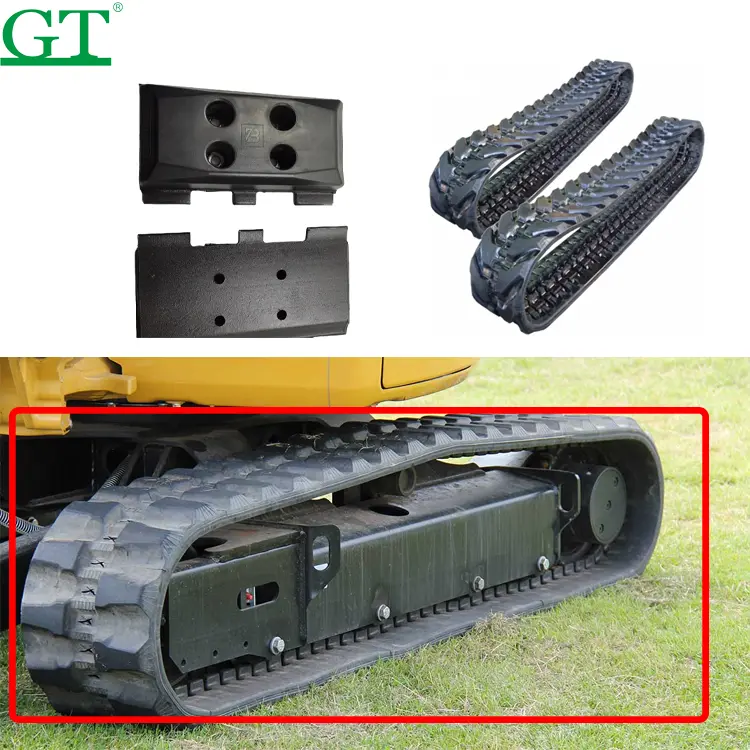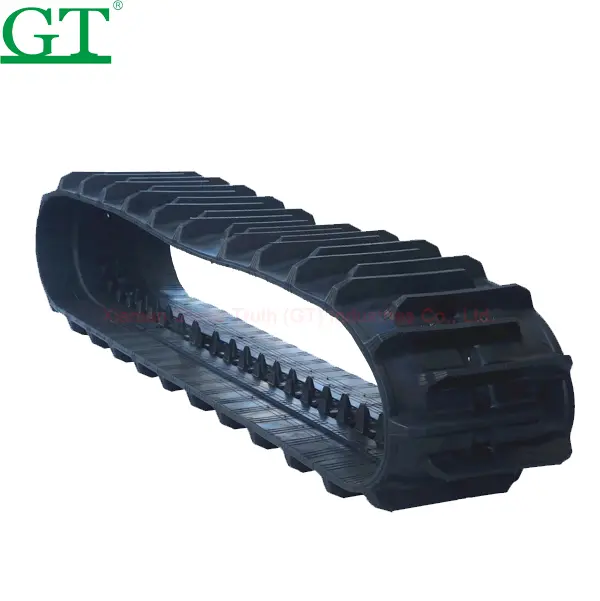The Role of Rubber Tracks in Enhancing Operational Efficiency
How Rubber Tracks Improve Mobility and Reduce Downtime in Construction Machinery
Construction machines can actually move around rough ground and narrow spots much better when they have rubber tracks instead of steel ones. These rubber tracks cut down on slipping problems by roughly 40% when working on soft dirt or steep hillsides. Another big plus is that rubber isn't as heavy as steel, so it puts less stress on the whole machine. Most modern rubber tracks also come with steel reinforcements inside them, which helps prevent damage when the equipment needs to exert real force. Because of these features, many operators find themselves needing to stop for maintenance less often too. Maintenance periods tend to stretch out somewhere between 20% to maybe even 35% longer than with traditional options. That means machines stay running longer through tough jobs without constant tinkering.
Advantages of Rubber Tracks in Material Handling and Sensitive Worksite Environments
When it comes to distributing weight across different terrains, rubber tracks have a clear advantage over both traditional tires and steel alternatives. They significantly reduce ground pressure what some tests show around 80% less on common surfaces such as asphalt roads or grassy areas. For anyone working on sensitive sites where soil compaction matters, this characteristic makes rubber tracks a go to solution for things like garden installations or city sidewalk repairs without tearing up the surrounding area. Plus, there's another benefit operators notice right away the vibrations are cut down roughly half compared to other options. This smoother ride means better handling precision especially important when moving fragile items across job sites.
Compatibility With Mini Excavators, Drilling Rigs, and Compact Construction Equipment
Rubber track systems today are built specifically for compact machines, giving them good grip without making engines work too hard. Some newer models mix rubber with Kevlar cords inside, which actually lets these tracks hold up drilling equipment weighing around 15 tons even when the ground isn't stable. Contractors have noticed something interesting lately. According to a recent survey from last year, nearly 8 out of 10 people who operate small excavators with rubber tracks say they replace parts less often compared to when they used steel tracks. The reason? These modern tracks come with special compounds that resist heat better, so components don't wear down as quickly in tough conditions.

Equipment-Specific Rubber Track Solutions for Maximum Performance
Drilling Rig Applications: Stability and Precision on Fragile or Urban Sites
The rubber tracks used on drilling equipment really focus on how weight gets spread out across the ground and also help dampen vibrations. This matters a lot when operating on shaky soil conditions or close to structures that are already there. When these systems are set up right, they can cut down ground pressure by around 60 percent compared with traditional steel alternatives, which helps stop the ground from sinking in places where it shouldn't. For machines working in cities, manufacturers typically equip them with special treads designed to make less noise, usually keeping things below 72 decibels so they meet city rules without sacrificing traction on roads and other paved areas.
Excavator Rubber Tracks: Merging Agility with Long-Term Endurance
The best excavator tracks today offer great maneuverability even when space is tight, while their steel cores can last well beyond 12,000 hours of operation. The rubber used in these tracks stands up to extreme temperatures ranging between minus 40 degrees Celsius all the way up to plus 120, which means they won't crack when conditions change quickly as often happens at mines and demolition sites. Many top brands are now producing X pattern lugs that actually clear mud away about 40 percent quicker compared to older models. This makes a big difference for keeping grip on slippery surfaces where traditional designs would struggle to maintain control.
Adaptation for Loaders, Compactors, and Skid Steers in Multi-Role Operations
The loaders and skid steers really get a boost from those dual density rubber layers they have these days, something like 65 Shore A on top and 75 Shore A underneath. The softer top part protects whatever surface it's running over, while the harder bottom gives solid support when carrying heavy loads. We've seen some field testing results too interesting stuff actually. These rubber tracks compact the soil about 25 percent less compared to their steel counterparts. Pretty impressive considering they still manage to deliver around 90 percent of the pushing power needed even on different kinds of ground conditions. Makes sense why so many operators are switching over now.
How to Select the Right Rubber Track Size and Configuration
Matching Track Dimensions to Machine Weight, Power Output, and Usage Intensity
Correct track sizing ensures stability and cost-effective operation. Mismatched dimensions can strain undercarriage components–incorrect tension alone accelerates wear by up to 40% in high-torque applications. Key selection factors include:
- Machine weight: Heavier machines require wider tracks (≥18" for 10-ton excavators) to evenly distribute pressure.
- Power output: High-torque rigs need steel-reinforced cores with tensile strength above 12,000 psi to resist stretching.
- Usage intensity: Continuous operations benefit from 6-ply rubber construction, which manages heat better than standard 4-ply designs.
Industry analysis shows that oversizing tracks by 10% reduces component fatigue in mini excavators by 22%, while undersized tracks increase fuel consumption by 15% due to slippage.
Precision Sizing for Optimal Fit, Alignment, and Wear Distribution
Accurate measurements prevent premature failure in drive sprockets and rollers. For compact machines like skid steers, even a 3mm deviation in width creates misalignment risks in 78% of cases. Use OEM-recommended gauge blocks to verify:
- Pitch length: Must match sprocket teeth (standard: 3.5" for compactors, 5" for medium excavators)
- Guide lug height: Essential for lateral stability; minimum 25mm recommended for rough terrain
- Track tension: Maintain within ±5% of factory specs using hydraulic tensioners to account for thermal expansion
Proper alignment extends track life by 30–50%, ensuring even wear across all lugs instead of localized abrasion.
FAQ
What are the main advantages of using rubber tracks over steel tracks?
Rubber tracks offer improved mobility, reduce slippage by 40%, cause less stress due to their lighter weight, and extend maintenance periods by 20-35% compared to steel tracks.
Are rubber tracks suitable for sensitive worksite environments?
Yes, rubber tracks distribute weight better and reduce ground pressure by up to 80%, making them ideal for sensitive sites like gardens or city sidewalks where soil compaction should be minimized.
How do rubber tracks enhance equipment like mini excavators?
Modern rubber tracks provide excellent grip and require less frequent part replacement due to heat-resistant compounds, benefiting machinery such as mini excavators.
What's the difference between steel-reinforced and all-rubber cores?
Steel-reinforced tracks offer higher load capacity and puncture resistance, whereas all-rubber cores are lighter and cause less ground impact, suitable for sensitive surfaces.
How does tread design impact equipment performance?
Optimized tread patterns enhance traction and reduce ground damage, improving equipment productivity by 10-20% depending on terrain conditions.
Table of Contents
- The Role of Rubber Tracks in Enhancing Operational Efficiency
- Equipment-Specific Rubber Track Solutions for Maximum Performance
- How to Select the Right Rubber Track Size and Configuration
-
FAQ
- What are the main advantages of using rubber tracks over steel tracks?
- Are rubber tracks suitable for sensitive worksite environments?
- How do rubber tracks enhance equipment like mini excavators?
- What's the difference between steel-reinforced and all-rubber cores?
- How does tread design impact equipment performance?




